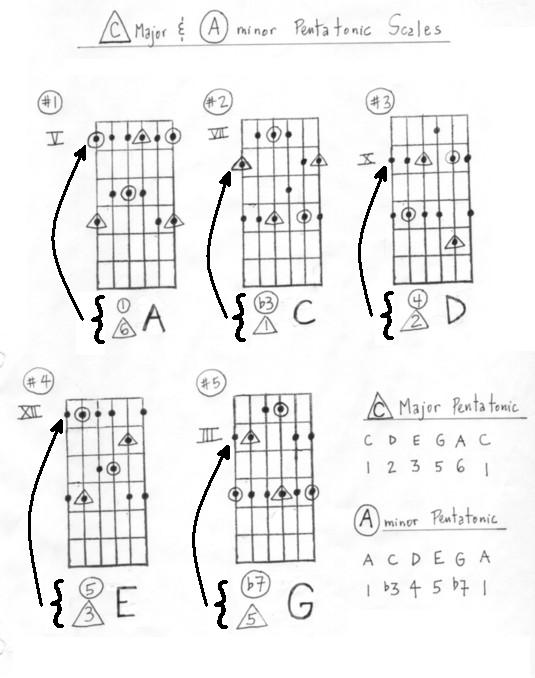Introduction...
In Lesson 9, I introduced the internals of a minor pentatonic scale. In this lesson, I will do the same for a major pentatonic scale. However, before I get into the gory details, let me just tell you right now that both the major and minor pentatonic scales have the same exact fingerings!
And, this should come as no surprise if you understand the concept of relative major/minor scales. After all:
- a major pentatonic scale contains the same notes as a major scale minus the 4th and 7th scale degrees.
- and a minor pentatonic scale contains the same notes as a natural minor scale minus 2nd and 6th scale degrees.
C Major Pentatonic, A Minor Pentatonic - It's the same thing!
What this means for a guitar player is that you don't have to learn any new pentatonic patterns, you just have to learn how to use the minor pentatonic scale in a different way. Let's look at a concrete example to illustrate some points:
An A minor pentatonic scale has the following makeup:
| Root | b3 | 4 | 5 | b7 | Root |
|---|---|---|---|---|---|
| A | C | D | E | G | A |
Now, let's pretend that the C note is the root of the scale. What do we get?
| Root | 2 | 3 | 5 | 6 | Root |
|---|---|---|---|---|---|
| C | D | E | G | A | C |
We get a C major pentatonic scale. Play "Pattern 2" from Lesson 10 to hear the sound of this scale. And if you listen carefully, you will hear a "major" sounding scale, not a "minor" one. (A sure fire way to hear this is to start and end the pentatonic scale on a C note. Play a C major chord and then play the scale again.) I find this quite interesting.
So why does this work? Well, it comes back the relative nature of music. That is, when we play the notes A, C, D, E, G and A in an A minor context, we get an A minor pentatonic scale. When we play these same notes in a C major context, we get a C major pentatonic scale.
A Playing Exercise: Record yourself playing the following vamp: an Am chord for 8 measures followed by a C major chord for 8 measures. Repeat these 16 bars for a few minutes. Then play a C major/A minor pentatonic scale over the vamp. Listen to how the scale's tonal center changes between a "major" and "minor" sound.
It is important to understand this connection between major and minor pentatonic scales. It will help you "get around" the tonal jungle of music (and the fingerboard too). I use this idea all the time when I improvise.
A Picture Is Worth A Thousand Words
I learn best by the use of pictures, so here is a diagram representing the relationship between major and minor pentatonic scales:

All of the circled notes (fingerings) on the diagram are A notes while all of the tri-angled notes on the diagram are C notes. If we look at the first pattern, the lowest note is an A. It is the root of an A minor pentatonic scale yet it is also the 6th of a C major pentatonic scale. That's what the little numbers under each pattern are meant to convey - the function of the lowest note in each pattern for both the A minor and C major pentatonic scales.
If we look at the last pattern on the diagram, pattern #5, we see that the lowest note is a G. G is a b7 in an A minor pentatonic scale (hence the b7 with a circle around it) yet it is also a 5th in a C major pentatonic scale (hence the 5 with a triangle around it).
Study this diagram well and be sure that you understand it completely. Keep in mind, the A minor pentatonic scale and the C major pentatonic scale have the same notes. They just function (or sound) differently depending upon the context in which they are played (heard).
Go to the next lesson, Lesson 17, or go back to the main menu.